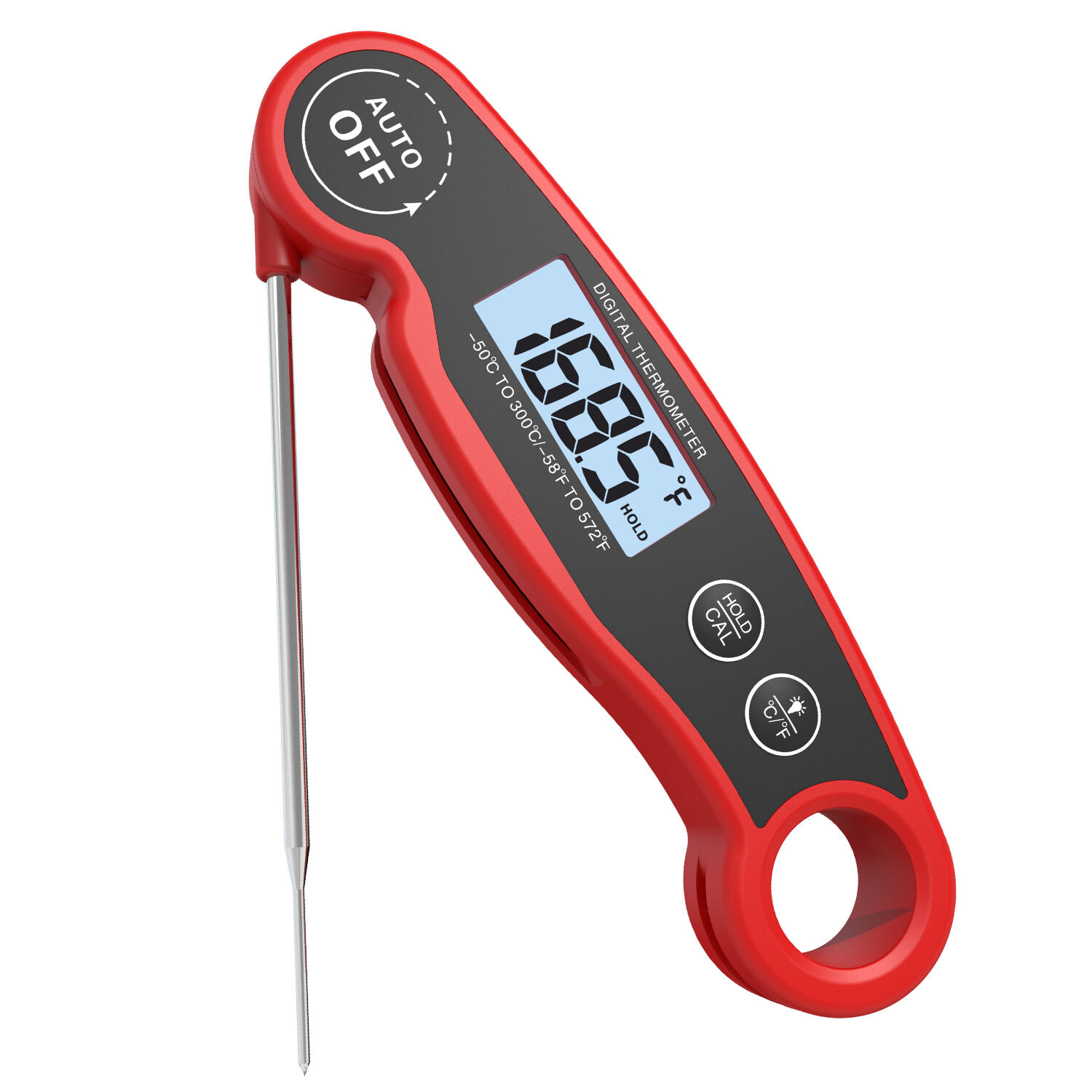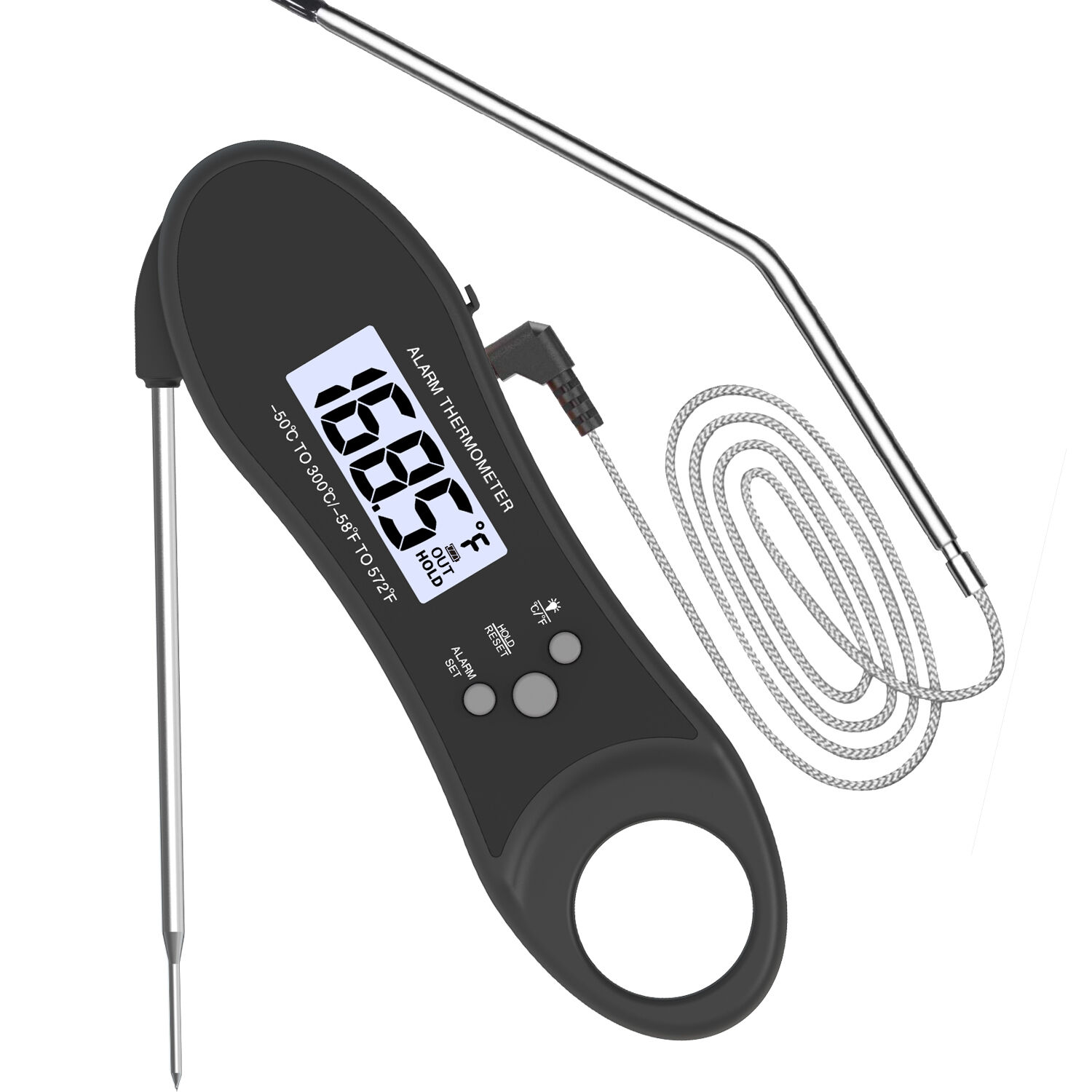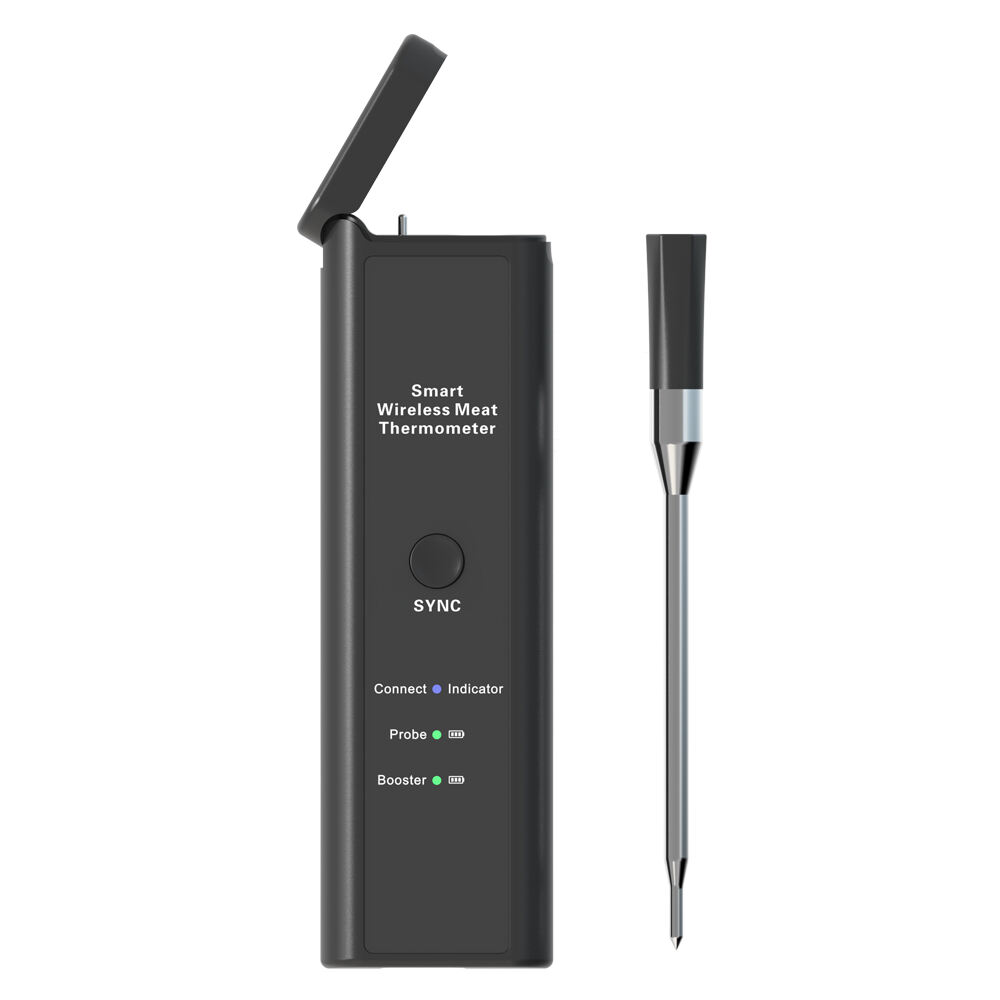Беспроводные термометры для продуктов необходимы для обеспечения последовательных и точных показаний температуры на коммерческих кухнях, гарантируя как безопасность пищи, так и её качество. Точность этих устройств имеет решающее значение; исследования показали, что правильный мониторинг температуры может снизить риск пищевых отравлений более чем на 30%. Такая точность предотвращает подачу недожаренной пищи, защищая как посетителей, так и репутацию заведения. Помимо этого, передовые технологии, используемые в этих термометрах, минимизируют человеческий фактор. Это позволяет шеф-поварам сосредоточиться больше на кулинарном мастерстве, не беспокоясь о том, что неточные измерения повлияют на безопасность и качество их блюд.
Одним из значительных преимуществ беспроводных систем в кухнях является предоставление мониторинга данных в реальном времени, что позволяет немедленно реагировать на любые колебания температуры. Исследования показывают, что правильный мониторинг может сократить пищевые отходы примерно на 20%, что приводит к существенной экономии затрат и ресурсов. Интеграция этих данных о температуре в управление запасами позволяет кухням еще больше оптимизировать использование stocks, минимизируя порчу и обеспечивая эффективное использование ингредиентов. В результате коммерческие кухни могут работать более экономично, а также способствовать устойчивому развитию за счет снижения пищевых отходов.
Возможность удаленного мониторинга температуры повышает производительность персонала в загруженных кухонных условиях. С беспроводными пищевыми термометрами сотрудники могут эффективно выполнять несколько задач одновременно, что способствует более продуктивной работе кухни. Исследования отрасли показывают, что использование систем беспроводного мониторинга может увеличить производительность на 15%. Это не только оптимизирует процессы, но и значительно снижает необходимость постоянных ручных проверок, освобождая персонал для выполнения других важных задач на кухне. Такая эффективность приводит к более плавному функционированию кухни, что в конечном итоге улучшает время обслуживания и доставки еды.
Профессиональные беспроводные термометры предлагают широкий температурный диапазон от -50°C до 300°C, что делает их универсальными инструментами для различных методов приготовления пищи. Этот широкий спектр позволяет поварам плавно переходить от замораживающих процедур к жарке и выпечке при высоких температурах, удовлетворяя разнообразные кулинарные потребности. Например, будь то приготовление нежных сладких изделий или жарка сочной говядины, эти термометры обеспечивают точные измерения для достижения идеального результата. Возможность измерения таких экстремальных температур делает эти инструменты незаменимыми для профессиональных поваров, стремящихся к точности и последовательности в своих кулинарных творениях.
В оживленных коммерческих кухнях риск брызг и пролитий неизбежен, поэтому водонепроницаемая защита IP66/IP67 является важной характеристикой беспроводных термометров. Эти рейтинги гарантируют, что термометры могут выдерживать влагу и интенсивные процедуры очистки, обеспечивая их работоспособность и гигиеничность. Помимо защиты целостности термометра, эта функция также увеличивает срок службы устройства и минимизирует затраты на обслуживание, что критично при работе в хаотичной и быстротечной среде профессиональных кухонь. Благодаря интеграции водонепроницаемых технологий, профессионалы кулинарного дела могут поддерживать гигиену и эффективность без беспокойства о старении устройства.
Функция двойного датчика является выделяющейся особенностью в профессиональных беспроводных термометрах, позволяя поварам одновременно отслеживать несколько блюд или различные части внутри одного кулинарного прибора. Эта возможность особенно ценна для обеспечения равномерной готовки и точного определения температуры различных видов белков, таких как мясо, которое требует точных уровней прожарки. На практике термометры с двойным датчиком значительно повышают точность приготовления, упрощая процесс подготовки, экономя время и снижая необходимость использования нескольких устройств. Эта функция критически важна для профессиональных кухонь, где требуется точность и эффективность при выполнении задач по приготовлению пищи.
Термометр DT-123 показывает отличные результаты в оживленных кухонных условиях благодаря своей высокоскоростной реакции, что сокращает время ожидания при измерении температуры и повышает эффективность рабочего процесса. Он оснащен быстрым временем отклика 2-4 секунды, что позволяет шеф-поварам быстро проверять степень готовности мяса и других продуктов на различных станциях. Кроме того, функция магнитного крепления обеспечивает использование без использования рук, легко прикрепляясь к металлическим поверхностям для удобного доступа во время готовки. Эта конструкция гарантирует, что профессиональные повара смогут эффективно управлять множеством кухонных задач без каких-либо помех.

DT-96 предлагает передовые функции для современных кухонь, включая возможности умного мониторинга, подключенного к приложению. Это позволяет шеф-поварам отслеживать и анализировать данные о температуре в реальном времени на их мобильных устройствах, обеспечивая точную готовку. Его перезаряжаемая природа снижает неудобства и затраты, связанные с частой заменой батарей, гарантируя надежность при непрерывном использовании. Термометр также оснащен двойной датчиковой функциональностью, что позволяет одновременно контролировать различные блюда или зоны готовки, оптимизируя процесс приготовления и обеспечивая равномерную прожарку белков.

Беспроводной термометр для мяса DT-128 выделяется благодаря своим возможностям с поддержкой Bluetooth, что позволяет поварам контролировать процесс приготовления без привязки к кухонному оборудованию. Его многосенсорная система обеспечивает детальный контроль нескольких продуктов, значительно улучшая надзор за приготовлением пищи. Используя технологию Bluetooth, DT-128 обеспечивает бесшовную связь в современных кухонных системах, позволяя поварам сохранять контроль над своими кулинарными творениями с точностью и эффективностью.

Внедрение беспроводных термометров в массовые кухонные операции требует стратегической интеграции с существующими рабочими процессами. Успешная интеграция предполагает понимание и адаптацию этих процессов для учета новых систем мониторинга, гарантируя, что они дополняют, а не нарушают ежедневные операции. Обучение персонала правильному использованию этих новых устройств является ключевым; оно помогает обеспечить плавный переход и максимально использовать преимущества таких современных технологий. Эффективная интеграция приводит к оптимизированным операциям, обеспечивая более точные данные, отражающие реальную производительность кухни, тем самым повышая общую продуктивность и эффективность.
Беспроводные термометры являются революционными инструментами для оптимизации процессов приготовления партий блюд, особенно в условиях, требующих высокопроизводительного производства. Обеспечивая равномерный контроль температуры во всех партиях, эти устройства помогают минимизировать вариации качества пищи, что является ключевым фактором для поддержания стандартов в загруженных кухнях. Повара могут использовать эти термометры для тщательного мониторинга больших объемов еды, обеспечивая точность без ущерба для вкуса или безопасности. Таким образом, они предлагают бесценный ресурс для сохранения последовательности, что важно для удовлетворенности клиентов и операционного успеха в динамичных условиях.
Внедрение комплексных протоколов обслуживания является ключевым для обеспечения долгосрочной надежности и точности беспроводных термометров. Регулярная калибровка необходима для соблюдения стандартов соответствия и обеспечения оптимальной производительности. Эти проверки служат защитой от неточностей, которые могут нарушить безопасность и качество пищи. Обучение персонала выполнению регулярного обслуживания и устранения неполадок имеет решающее значение, так как это увеличивает срок службы этих устройств и повышает как безопасность, так и операционную эффективность. Прогностическое управление этими задачами обслуживания способствует устойчивой работе кухни, поддерживая постоянное качество и производительность со временем.
Автоматический учёт температуры — это прорыв в поддержании тщательных записей для проверок соответствия требованиям безопасности пищевых продуктов. Этот цифровой метод минимизирует риск человеческой ошибки и гарантирует, что точные записи температуры всегда доступны для проверки. Регулярное использование систем автоматического учёта облегчает соблюдение стандартов HACCP (Анализ опасностей и критических контрольных точек), предоставляя надёжные данные. Такой системный подход не только повышает готовность к аудиту, но и усиливает доверие к практикам обеспечения безопасности пищевых продуктов.
Системы оповещения, настроенные на критические контрольные точки, являются ключевыми для поддержания высоких стандартов безопасности пищевых продуктов. Они позволяют устанавливать конкретные температурные пороги, оповещая персонал, когда необходимо принять корректирующие меры, тем самым минимизируя риски, связанные с человеческим контролем. Согласно исследованиям, интеграция систем оповещения в рабочие процессы кухни может снизить вероятность нарушений безопасности пищевых продуктов более чем на 40%. Эта система обеспечивает проактивный подход к поддержанию безопасности, значительно снижая риск ошибок при соблюдении нормативов.
Правильные процедуры калибровки критически важны для обеспечения точности и надежности беспроводных термометров, особенно с учетом требований FDA. Регулярные проверки калибровки поддерживают точность измерений, соответствуют санитарным нормам и защищают интересы как потребителей, так и бизнеса. Установление регулярных графиков калибровки является ключевым фактором в предотвращении дорогостоящих нарушений нормативов, гарантируя оптимальную работу термометров со временем. Строгое следование этим процедурам позволяет компаниям поддерживать свою приверженность безопасности пищевых продуктов и системе управления качеством.
В примечательном случае внедрения беспроводных систем мониторинга в коммерческих курильщиках было достигнуто сокращение энергетических затрат на 25%. Этот результат подчеркивает важность эффективного термического управления, которое не только приводит к финансовой экономии, но и способствует экологической устойчивости за счет снижения углеродного следа кулинарных операций. Интеграция энергоэффективного оборудования с реальным временем мониторинга позволяет предприятиям значительно повысить операционную эффективность и прибыльность. Эти улучшения демонстрируют критическую роль технологии в оптимизации использования ресурсов.
Достижение сокращения перегрева белка на 30% стало возможным благодаря использованию точного мониторинга температуры во время приготовления пищи. Этот подход привел к повышению качества пищи и улучшению вкуса, подчеркивая преимущества применения передовых инструментов в кулинарных практиках. Кроме того, минимизация перегрева переводится в значительную экономию затрат, так как она сохраняет порции еды и снижает отходы. Данные ясно показывают, что инвестиции в точные мясные термометры или беспроводные кулинарные термометры являются ключевым фактором для улучшения как экономической эффективности, так и удовлетворенности клиентов.
Несколько ресторанов успешно избежали штрафов за несоответствие нормам благодаря использованию точных беспроводных устройств для мониторинга температуры. Постоянно отслеживая температуру, эти заведения обеспечивают соблюдение санитарных норм безопасности продуктов и могут оперативно решать возникающие проблемы. Этот проактивный подход к мониторингу не только защищает от возможных штрафов, но и положительно влияет на финансовые показатели. Стратегическое использование технологий для поддержания соответствия нормам демонстрирует его воздействие на операционные процессы, подчеркивая важность надежных систем мониторинга в индустрии общественного питания.
Управление температурой с использованием ИИ представляет собой революционное достижение в работе кухни. Анализируя исторические данные о температуре, ИИ может прогнозировать будущие потребности в нагреве или охлаждении, оптимизируя условия кухни без сбоев. Эта возможность значительно снижает необходимость в ручных настройках, гарантируя, что пища остается в безопасной температурной зоне эффективно. Интересно, что эксперты отрасли предсказывают, что темпы внедрения ИИ в кухонные технологии существенно возрастут в ближайшие пять лет. Этот тренд подчеркивает возрастающую важность использования технологий ИИ для повышения операционной эффективности в ресторанах и коммерческих кухнях.
Интеграция термометров с системами управления запасами революционизирует способ, которым кухни управляют пищевыми ресурсами. Предоставляя единое представление о управлении продуктами, это синергия позволяет оптимально контролировать запасы на основе реальных данных о температуре и шаблонах использования. Стоит отметить, что данные, собранные с помощью термометров, играют ключевую роль в прогнозировании потребностей в запасах, значительно снижая количество отходов. Этот интегрированный подход не только обеспечивает точное управление ресурсами кухни, но также повышает общую устойчивость операций по обслуживанию питания за счет минимизации избыточных запасов.
С появлением многоустройственных сетей меш, крупные кухни теперь могут подключать несколько устройств для широкого охвата и улучшения потока данных. Эта технология обеспечивает бесшовное взаимодействие между различными устройствами, расширяя возможности сбора данных и мониторинга в масштабных операциях. Конечный результат — повышение операционной эффективности, что критически важно для пищевых сред с высокой пропускной способностью. Обеспечивая эффективное взаимодействие устройств и точную передачу данных, сети меш позволяют кухням оптимизировать свои процессы и повысить эффективность управления большими объемами кулинарных задач.